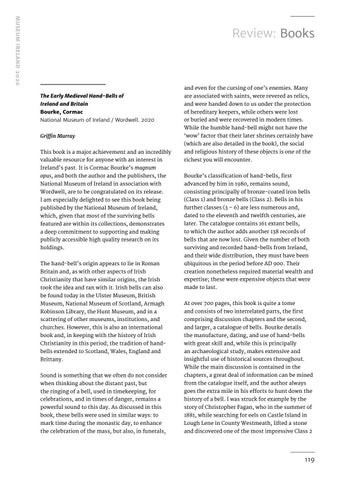MUSEUM IRELAND 2020
Review: Books
and even for the cursing of one’s enemies. Many The Early Medieval Hand-Bells of
are associated with saints, were revered as relics,
Ireland and Britain
and were handed down to us under the protection
Bourke, Cormac
of hereditary keepers, while others were lost
National Museum of Ireland / Wordwell. 2020
or buried and were recovered in modern times. While the humble hand-bell might not have the
Griffin Murray
‘wow’ factor that their later shrines certainly have (which are also detailed in the book), the social
This book is a major achievement and an incredibly
and religious history of these objects is one of the
valuable resource for anyone with an interest in
richest you will encounter.
Ireland’s past. It is Cormac Bourke’s magnum opus, and both the author and the publishers, the
Bourke’s classification of hand-bells, first
National Museum of Ireland in association with
advanced by him in 1980, remains sound,
Wordwell, are to be congratulated on its release.
consisting principally of bronze-coated iron bells
I am especially delighted to see this book being
(Class 1) and bronze bells (Class 2). Bells in his
published by the National Museum of Ireland,
further classes (3 – 6) are less numerous and,
which, given that most of the surviving bells
dated to the eleventh and twelfth centuries, are
featured are within its collections, demonstrates
later. The catalogue contains 161 extant bells,
a deep commitment to supporting and making
to which the author adds another 138 records of
publicly accessible high quality research on its
bells that are now lost. Given the number of both
holdings.
surviving and recorded hand-bells from Ireland, and their wide distribution, they must have been
The hand-bell’s origin appears to lie in Roman
ubiquitous in the period before AD 900. Their
Britain and, as with other aspects of Irish
creation nonetheless required material wealth and
Christianity that have similar origins, the Irish
expertise; these were expensive objects that were
took the idea and ran with it. Irish bells can also
made to last.
be found today in the Ulster Museum, British Museum, National Museum of Scotland, Armagh
At over 700 pages, this book is quite a tome
Robinson Library, the Hunt Museum, and in a
and consists of two interrelated parts, the first
scattering of other museums, institutions, and
comprising discussion chapters and the second,
churches. However, this is also an international
and larger, a catalogue of bells. Bourke details
book and, in keeping with the history of Irish
the manufacture, dating, and use of hand-bells
Christianity in this period, the tradition of hand-
with great skill and, while this is principally
bells extended to Scotland, Wales, England and
an archaeological study, makes extensive and
Brittany.
insightful use of historical sources throughout. While the main discussion is contained in the
Sound is something that we often do not consider
chapters, a great deal of information can be mined
when thinking about the distant past, but
from the catalogue itself, and the author always
the ringing of a bell, used in timekeeping, for
goes the extra mile in his efforts to hunt down the
celebrations, and in times of danger, remains a
history of a bell. I was struck for example by the
powerful sound to this day. As discussed in this
story of Christopher Fagan, who in the summer of
book, these bells were used in similar ways: to
1881, while searching for eels on Castle Island in
mark time during the monastic day, to enhance
Lough Lene in County Westmeath, lifted a stone
the celebration of the mass, but also, in funerals,
and discovered one of the most impressive Class 2
119















